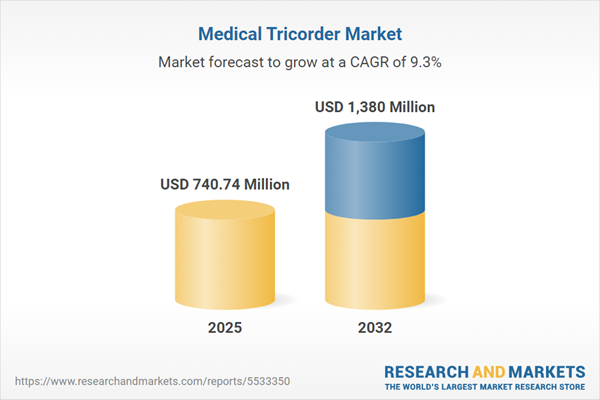Speak directly to the analyst to clarify any post sales queries you may have.
The global medical tricorder market is reshaping healthcare by enhancing diagnostic efficiency and supporting more agile, adaptable operations. For senior decision-makers, adopting innovative tricorder technologies offers a path to improved clinical outcomes, reduced operational delays, and greater resilience in the face of rapid digital transformation.
Market Snapshot: Medical Tricorder Market Size and Growth
In 2024, the medical tricorder market reached a value of USD 677.42 million, spurred by integration with digital diagnostic platforms. The sector is set for a 9.32% CAGR, targeting USD 740.74 million in 2025 and almost USD 1.38 billion by 2032. This growth reflects increasing prioritization of accurate diagnostics and operational streamlining. Leading stakeholders leverage digital systems to expand remote care and support essential healthcare workflows. As the market modernizes, investment in scalable, flexible solutions is accelerating to meet the evolving needs across both clinical and community sectors.
Scope & Segmentation of the Medical Tricorder Market
- End Users: Home healthcare organizations use medical tricorder solutions for tailored patient oversight and recovery monitoring. Hospitals deploy these technologies to optimize resource distribution and streamline clinical interventions. Academic centers play a vital role by validating device efficacy and advancing research initiatives in real patient environments.
- Applications: Medical tricorders cover chronic disease management, preventive monitoring, advanced diagnostic imaging, and thermal assessments. Their adaptability ensures value both for clinics and for in-home use.
- Product Types: Devices include handheld, portable, and wearable medical tricorders, supporting real-time data capture and continuous patient evaluation in hospital and remote settings alike.
- Technologies: Embedded biosensors with optical and electrochemical components integrate seamlessly into diagnostic workflows, enabling instant clinical analysis and supporting proactive, data-driven care.
- Geographies: The Americas lead due to robust healthcare ecosystems and rapid technology adoption, while EMEA benefits from strong regulatory frameworks and increased demand for digital innovation. Asia-Pacific is experiencing growth as new applications emerge to support expanding healthcare infrastructures.
- Leading Companies: Major players such as QuantuMDx Group, Cloud Dx, Basil Leaf Technologies, Medipense Inc., Aidar Health Inc, and Tricorder.Zero are dedicated to product innovation and extending market presence across healthcare settings.
Key Takeaways for Senior Decision-Makers
- Diverse device formats encourage organizations to build adaptable care delivery models, ensuring clinicians and patients remain tightly connected for seamless care coordination.
- Collaborations between technology developers and care providers enhance data interoperability and strengthen clinical data security across platforms and workflows.
- Ongoing improvements in biosensor technology and medical imaging allow organizations to adapt rapidly, maintaining high standards of diagnostic precision and workflow flexibility.
- Evolution in regulatory and reimbursement environments mitigates risk, helping organizations maintain consistent access to diagnostic tools as supply chains change.
- Comprehensive market segmentation offers leadership teams the actionable insights needed to refine investment decisions for diverse environments, including acute care, home health settings, and academic centers.
- Increased utilization of biosensors and advanced analytics strengthens the adaptability of medical tricorder platforms, allowing faster response to varied patient needs.
Tariff Impact: Addressing U.S. Trade Policy and Supply Chain Strategy
Shifting U.S. trade policies have introduced additional cost pressures on essential medical tricorder elements such as biosensors and imaging modules. In response, organizations are broadening procurement strategies by emphasizing local manufacturing, diversifying sourcing channels, and evolving their approaches to supply chain management. These efforts help maintain consistent innovation and ensure dependable product delivery as international regulatory landscapes shift.
Methodology & Data Sources
This analysis draws from systematic reviews of peer-reviewed journals, industry reports, and verified clinical studies. Insights from engineering, procurement, and healthcare experts contribute to a thorough view of current technical progress and real-world adoption within the medical tricorder sector.
Why This Report Matters
- Presents clear, actionable intelligence to inform investment planning for technology leaders aiming to upgrade digital healthcare processes and care continuity.
- Offers detailed segmentation that supports alignment of technology deployment with operational, clinical, and regional demands, ensuring strategies are tailored effectively.
- Strengthens strategic risk management by assessing how regulatory shifts and supply chain dynamics create new opportunities and alter the competitive landscape.
Conclusion
Sustained advancement in the medical tricorder market relies on digital adoption, resilient industry partnerships, and adaptive leadership. Organizations prioritizing scalable diagnostic solutions are well-positioned to deliver stable operations and improved care in a rapidly evolving environment.
Additional Product Information:
- Purchase of this report includes 1 year online access with quarterly updates.
- This report can be updated on request. Please contact our Customer Experience team using the Ask a Question widget on our website.
Table of Contents
3. Executive Summary
4. Market Overview
7. Cumulative Impact of Artificial Intelligence 2025
Companies Mentioned
The companies profiled in this Medical Tricorder market report include:- QuantuMDx Group
- Cloud Dx
- Basil Leaf Technologies
- Medipense Inc.
- Aidar Health Inc
- Tricorder.Zero
Table Information
| Report Attribute | Details |
|---|---|
| No. of Pages | 191 |
| Published | October 2025 |
| Forecast Period | 2025 - 2032 |
| Estimated Market Value ( USD | $ 740.74 Million |
| Forecasted Market Value ( USD | $ 1380 Million |
| Compound Annual Growth Rate | 9.3% |
| Regions Covered | Global |
| No. of Companies Mentioned | 7 |









